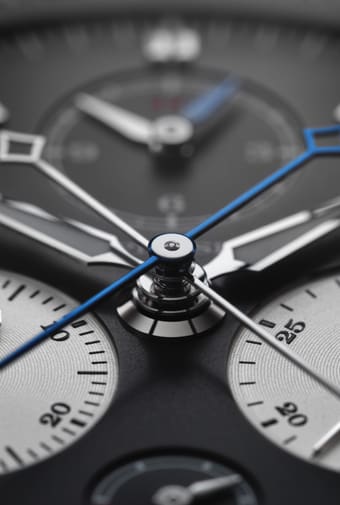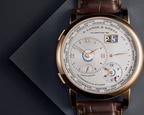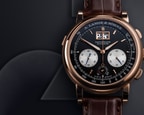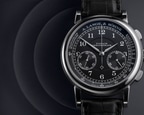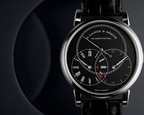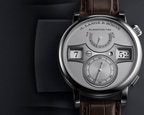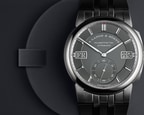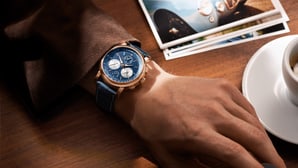Stopping without standing still
The A. Lange & Söhne chronographs are arguably among the most coveted in the world. Apart from their precision and mechanical intricacy, they enthral in particular because of the exceptional artisanal artistry, the “Handwerkskunst” that is bestowed on the movements. The captivating architecture and the elaborate finissage of, in some cases, more than 700 precisely harmonised parts can be admired through the sapphire-crystal caseback of the watch.
A new way of recording time
The DATOGRAPH was the first A. Lange & Söhne chronograph developed and crafted in our manufacture after the re-establishment. With its singular combination of a sophisticated manufacture calibre and well-organised dial, it is still today a benchmark in the art of short-time measurement, and a symbol of the innovative powers of the manufacture.
Not unlike timepieces with a tourbillon or a perpetual calendar, chronographs are among the powerful challenges in precision watchmaking. It was a trailblazing event when this proprietary new concept was presented only such a short time after the relaunch of A. Lange & Söhne, and set a new standard of excellence in the construction of chronographs featuring their own movement. The DATOGRAPH paved the way for many further remarkable chronographs created in our manufacture that embody our commitment to push horological boundaries and to explore new avenues.
Special functions
In keeping with our high standards, we do not compromise when crafting our timepieces. Therefore, we build our chronographs in a specified way and equip them with special functions.
These include the classic column-wheel construction, the precisely jumping minute counter and the flyback function. With a single actuation of a pusher, this mechanism makes it possible to stop a running measurement, reset the hands to zero, and immediately start a new measurement. With chronographs that are not endowed with this function, these steps must be executed consecutively.
Split-seconds or rattrapante chronographs constitute another distinctive category. The French term “rattrapante” designates a second, pursuant or “catching-up” seconds hand of a chronograph. This hand can be stopped independently of the chrono seconds hand and resynchronised with it. Initially, both hands are superposed and congruent so that only the rattrapante hand is visible. When a time measurement is started, both hands start to run synchronously and the chrono seconds hand is still concealed. It only becomes visible when the first elapsed time is measured. The rattrapante hand remains stationary, while the chrono seconds hand continues to run. The chrono seconds hand also stops when a second elapsed time is measured. By following this procedure, two intermediate times with the same starting time can be compared, for example the lap times of two runners.
Any number of comparative measurements with a reference time can be taken by fully exploiting the characteristics of the chronograph and rattrapante mechanism. Even minimum and maximum values can be determined with a rattrapante chronograph, for instance the individual lap times of a horse and its total running time.
Unique chronographs and grand complications
In 2004, our manufacture presented the DOUBLE SPLIT ‒ a world premiere. For the very first time in the history of precision watchmaking, a chronograph with a double rattrapante was built. Not only does it have two seconds hands but also two minute counters. Both rattrapante hands can be stopped independently of the chronograph hands and resynchronised with these at a later stage, thus increasing the duration of intermediate measurements from 60 seconds to 30 minutes. The DOUBLE SPLIT also features a flyback function as well as precisely jumping minute counters.
In 2018, the TRIPLE SPLIT went one step further and opened up another dimension in the measurement of stopped times. With its triple rattrapante mechanism for seconds, minutes and hours, it allowed multi-hour comparative time measurements for the first time. The TRIPLE SPLIT can measure and compare individual and additive times, any number of intermediate and reference times as well as two events that started at the same time for as long as twelve hours ‒ with an accuracy of one sixth of a second.
The combination of a chronograph mechanism and other grand complications such as a perpetual calendar makes up a further category of fascinating watches. The first timepiece of this kind was the DATOGRAPH PERPETUAL, launched in 2006. With the debut of the 1815 RATTRAPANTE PERPETUAL CALENDAR in 2013, A. Lange & Söhne presented this sophisticated combination of a split-seconds chronograph and a perpetual calendar in a movement consisting of 631 components.
In 2016, the DATOGRAPH PERPETUAL TOURBILLON showcased an even greater horological complexity, accommodating a combination of three grand complications in its 729-part manufacture calibre: a flyback chronograph with a precisely jumping minute counter, an instantaneously switching perpetual calendar with a moon-phase display, an outsize date as well as a one-minute tourbillon with stop seconds.
The TOURBOGRAPH PERPETUAL “Pour le Mérite” is in a league of its own. One-of-a-kind, the fifth “Pour le Mérite“ masterpiece by A. Lange & Söhne unites five complications: a one-minute tourbillon with a fusée-and-chain transmission, a classic chronograph with rattrapante function as well as a perpetual calendar with a moon-phase display.
All our manufacture’s chronographs are emblematic of our commitment to never stand still ‒ and yet be able to stop the time.
Complications



Explore further



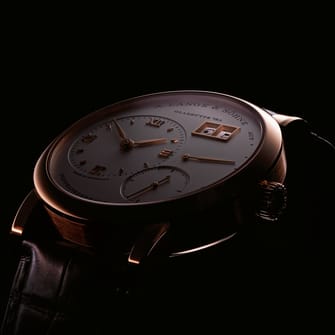
Exclusive insights into the world of fine watchmaking
Experience A. Lange & Söhne’s fascinating heritage, unique stories and exquisite timepieces by subscribing to our newsletter.
How can we be of service?
Whether you are in search of a specific model, have questions out of interest or need a service request for your timepiece – we are delighted to help you. We are at your service by phone, email or in one of our boutiques.

